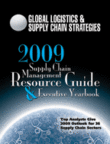
Visit Our Sponsors |
|
|
|
|
|
|
|
|
|
|
|
|
|
|
|
|
|
|
|
|
|
|
|
|
|
|
|
|
|
|
|
|
|
|
|
|
|
|

These are unprecedented times for global container shipping and for trans-Pacific container shipping-not just for the global economy. Asia-to-U.S. container traffic volumes had started their retreat into negative growth as long ago as the second quarter of 2007, and ocean carriers have had to terminate services, withdraw capacity and desperately seek reductions in their operating costs. They will continue this policy of active capacity retrenchment during 2009, with few exceptions. Much ship capacity will be mothballed.
Whether this will lead to international shippers experiencing difficulties securing active shipping capacity is harder to predict than in previous years, but it does not look as if wholesale capacity shortages will occur during 2009, as there are already many idle containerships "parked" in several ports around the world and ready to get back into service.
The ocean carrier industry is staring down the barrel of a phenomenal delivery program of vessels of 10,000 TEUs or greater (35 in 2009, 49 in 2010 and 91 in 2011), fueled by the ordering bonanza of 2007. Since then, however, growth rates in demand for container shipping services have dwindled and freight rates have fallen by 20 percent to 40 percent on the major container trade routes and about 70 percent on the major dry bulk routes.
It's clear that guaranteed 10 percent container volume growth is now past history in global container shipping. We all know about the adverse macro-economic conditions, scared consumers, falling car sales, etc., not to mention insufficient trade finance and corporate difficulties. It is consumers who drive most of the container imports from Asia, and imported containerized goods such as furniture will certainly be hit severely.
Westbound trans-Pacific freight rates have declined since the record levels seen in early 2008, and I would expect this trend to continue. Eastbound trans-Pacific freight rates, and particularly fuel surcharges, should decline in 2009.
Besides the forecast reduction in freight rates, what are the other transportation issues for shippers in the trans-Pacific container market?
• With the carrier practice of slow steaming now spreading, this will result in longer transit times (slower deliveries in some cases).
• Given the weak bargaining power of ocean carriers, some shippers could once more request fuel surcharges to be incorporated into a fixed "all-in" rate.
• By contrast, I would expect that the rail intermodal service component of IPI rates will continue to go up, and that it could become more cost advantageous to switch volumes from U.S. West Coast intermodal routes to "all-water" routes for certain destinations and for less time-sensitive products.
• The risk of ocean carrier failures and subsequent disruption of shippers' supply chains (including products left stranded before delivery) is high.
• More and more products are switching from air transport to sea transport or sea-air transport.
The Outlook
The market downturn in international container shipping will only deteriorate further in 2009 since fleet growth in the big ship sector will dramatically outpace demand. Slow-steaming strategies will doubtless continue, but this can only absorb a limited number of surplus vessels. The major conundrum for container shipping lines is where to deploy ships without lowering freight rates further.
For some ocean carriers, the agenda is not growth or market share, but survival. Exporters and importers in 2009 will have to anticipate and manage the risk of carrier failures in their transportation procurement policy. They should also think of how to secure capacity when market recovery comes.
If your agenda, as a logistics director, is to reduce transportation costs, it will be important to review all possible route combinations and mode combinations and to discuss your actual lead-time requirements with sales or purchasing colleagues. A more short-term execution of supply chain decisions may be required, using a wider array of predefined route options. This could help your company get the most out of your international transportation dollars in a weakening, volatile market.
RELATED CONTENT
RELATED VIDEOS
Timely, incisive articles delivered directly to your inbox.

